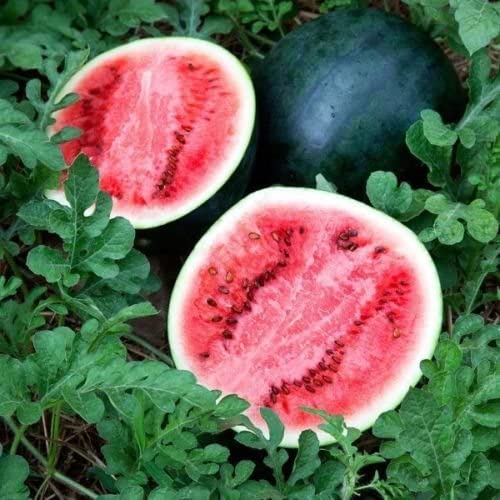Growing Organic Watermelon
Watermelons are easy to grow as long as you give the plant lots of sunlight, plenty of room to spread, good drainage, and a sufficiently long growing season. If you have a small garden but love to grow watermelons, you can try growing them on a trellis. But You need a very strong trellis, and you have to train them up the trellis because they aren't climbers they won't climb up on their own, and you need to support the developing fruit, so the trellis holds the weight, not the plant!
Gardeners in colder climates should choose early ripening varieties. Sugar Baby is the most popular watermelon varieties.
Sugar Baby
Watermelon Seeds are available Here!
Watch: Starting Watermelon Seeds Indoors
Where to Grow Watermelon
Watermelons spread out and take up too much space as you will give them. To make sure your melons have plenty of room to grow, It's important that check an area far away from the rest of your garden, and soon you will discover how big they will get. Watermelons need a location that receives at least 8 of sunlight per day. The plants prefer a soil pH between 6 and 6.8, and loamy, well-drained soil. As watermelons are heavy feeders. Before planting the seeds amend your soil with organic matter such as compost or well aged chicken manure.
Planting The Seeds
Watermelon seeds are small and black or slightly mottled black/brown in color. To ensure germination, you need to wait until the soil temperatures reach 70 degrees Fahrenheit before planting seeds.
- Mound the soil into small hills spaced 8' to 10' apart.
- Plant 3 seeds 1/2 to 1 inch deep.
- Cover the seeds with soil and water them. They germinate in about 10 days.
- When seedlings sprout, thin to just one plant, and keep it well watered.
The female flowers are larger, and you can already see the tiny melon beginning to form at the base of the flower.
Watermelon Plant Care
Watermelons have very shallow roots, and they need lots of moisture. The soil should never dry out and mulch can help with that. You can use pelleted chicken manure or another organic matter. As watermelons are hungry plants. Feed your plants regularly with organic fertilizer. First use a high nitrogen fertilizer in the early stages, and once they flower and begin to make fruits cut back on nitrogen and give them lots of potassium.
- Watering is very important. The plants need 1 to 2 inches of water per week.
- Keep your soil moist, but not waterlogged.
- Water at the vine’s base in the morning, and try to avoid wetting the leaves and avoid overhead watering.
- Reduce watering once fruit are growing.
- Pinch off some blossoms to let the plant focus all the energy on fewer melons to get bigger.
To get sweet watermelons you must give watermelon plants all they need all season. Give them the right amount of water, protection from diseases and pests, addition of extra nutrients to the soil, and good care you will get the sweetest watermelons. Dry weather produces the sweetest melon!
Watermelon Common Pests and Diseases
Watermelon plants can suffer from cucumber wilt, downy mildew, and powdery mildew. Early in the season you can use row cover to protect plants from pests.
Watermelon Harvesting
Storing Watermelon Seeds
Watermelon seeds are full of nutrients. They are a rich source of proteins, vitamins, omega 3 and omega 6 fatty acids, magnesium, zinc, copper, and potassium. All of these nutrients are essential for your brain and body.
In summary, watermelon is not only a refreshing summer snack, but also a nutrient-packed fruit that delights the palate and supports health. Its pleasingly sweet taste, along with its moisturizing abilities and high vitamin content, makes it an ideal supplement to any regular meal plan. And how could you enjoy its delicious taste more than by growing it naturally in your own garden? Homegrown watermelon not only ensures freshness and quality, but also enhances our connection with nature and the food we eat. So, whether you enjoy it as a snack or incorporate it into a smoothie, using watermelon in your cooking regularly guarantees both pleasure and health benefits. Here's to celebrating the pleasures of enjoying this flavorful fruit, cultivated with care and relished with enthusiasm!
Happy Organic Gardening!
From HERE you can buy and grow organic, heirloom watermelon seeds with superior flavor and early yield.
Happy Organic Gardening!
Affiliate Disclosure: In transparency and compliance with legal guidelines, please be aware that some of the links on this site are affiliate links. These are carefully chosen products that I have personally used, tested, and genuinely recommend. When you click and make a purchase through these links, I may earn a small commission, at no additional cost to you. This commission helps support the maintenance of this site, allowing me to continue providing valuable content and recommendations. Rest assured, my priority is to offer authentic and reliable information, and I only affiliate with products that align with the values and standards I uphold. Your trust means everything to me, and I appreciate your support. If you have any questions or concerns, please feel free to reach out. Thank you for being a valued part of our community!











